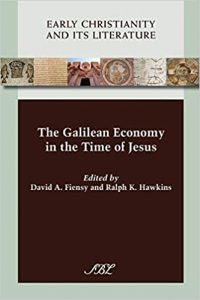Recomendo a leitura do artigo de David A. Fiensy, The Galilean Economy in the Time of Jesus: Can You Dig It? [A economia da Galileia na época de Jesus: é possível escavá-la?]. Publicado em The Bible and Interpretation em julho de 2013.
A pergunta é: qual era o padrão de vida da população da Galileia na época de Jesus?
Diz David A. Fiensy, Professor de Estudos Bíblicos na Kentucky Christian University, USA, e Associate Director of the Shikhin Excavation Project in (Galilee) Israel:
Devemos ser cautelosos em nossas tentativas para determinar a natureza da economia da Galileia na época de Jesus. Os dados são muitos fragmentários. A pesquisa atual sobre a Galileia do final do período do Segundo Templo é cheia de contrastes. Por exemplo: enquanto alguns olham para a Galileia através das lentes da antropologia cultural e da macrossociologia, outros olham para a Galileia através das lentes da arqueologia e rejeitam o uso de modelos construídos pelas ciências sociais; enquanto alguns sustentam que as relações entre aldeias e cidades eram hostis, outros propõem que havia uma relação de reciprocidade econômica; enquanto alguns sugerem que a Galileia era como outras sociedades agrárias da época com os camponeses pobres vivendo em áreas rurais e ricos exploradores vivendo principalmente em cidades, outros respondem que a vida era muito boa para todos na Galileia e que esta construíra uma sociedade igualitária… O autor defende, no final de seu artigo, a colaboração das duas áreas de pesquisa, a das ciências sociais e a da arqueologia, observando que grandes avanços foram feitos nos últimos 30 anos no conhecimento da Galileia da época de Jesus.
In trying to determine the nature of the Galilean economy, one must remain a bit humble. The nature of the data is fragmentary. This fact should both cause us to be cautious in our conclusions and to press for more data of the appropriate type. The central question in the “economy wars” (i.e. the debates between some Galilean archaeologists and some of those New Testament scholars utilizing social science models) is about the standard of living of the Galilean folk in the late Second Temple period.The current quest for the historical Galilee is a study in contrasts: 1) Some look at Galilee through the lenses of cultural anthropology and macro-sociology; others look at Galilee through the lenses of archaeology and reject the use of social theories. 2) Some maintain that the relations between rural villages and the cities were hostile; others propose that the relationship was one of economic reciprocity and good will. 3) Some suggest that Galilee was typical of other agrarian societies with poor peasants who lived in the rural areas and exploitative wealthy people who lived mostly in the cities; others respond that life was pretty good for everyone in Galilee and that it was an egalitarian society… Remarkable gains have been made in understanding Galilee in the late Second Temple period in the last 30 years. This is a credit to both fine archaeological work and to the study of the insights of the social sciences. We must continue to use all of the resources available as we advance this pursuit. I, for one, intend to drink from both wells in assessing Lower Galilee in the late Second Temple period.
Este artigo remete a um livro sobre o assunto publicado agora em agosto:
FIENSY, D. A.; HAWKINS, R. K. (eds.) The Galilean Economy in the Time of Jesus. Atlanta: Society of Biblical Literature, 2013, 208 p. – ISBN 9781589837577.
Disponível para download gratuito no Projeto ICI da SBL.
Diz a SBL em seu site:
A fim de fornecer um panorama e uma análise atualizada das condições econômicas da Galileia do século I d.C., esta coletânea pesquisa escavações arqueológicas recentes (Séforis, Yodefat, Magdala e Khirbet Qana) e analisa os resultados de escavações mais antigas (Cafarnaum). Ela também oferece interpretação das escavações para questões econômicas e apresenta os parâmetros do debate atual sobre o padrão de vida dos antigos galileus. Os ensaios incluídos, escritos por arqueólogos e estudiosos da Bíblia, foram elaborados a partir da perspectiva da arqueologia ou das ciências sociais. O volume, portanto, representa um amplo espectro de pontos de vista sobre esta questão oportuna e muitas vezes calorosamente debatida. Contribuem Mordechai Aviam, David A. Fiensy, Ralph K. Hawkins, Sharon Lea Mattila, Tom McCollough e Douglas Oakman.
In order to provide an up-to-date report and analysis of the economic conditions of first-century C.E. Galilee, this collection surveys recent archaeological excavations (Sepphoris, Yodefat, Magdala, and Khirbet Qana) and reviews results from older excavations (Capernaum). It also offers both interpretation of the excavations for economic questions and lays out the parameters of the current debate on the standard of living of the ancient Galileans. The essays included, by archaeologists as well as biblical scholars, have been drawn from the perspective of archaeology or the social sciences. The volume thus represents a broad spectrum of views on this timely and often hotly debated issue. The contributors are Mordechai Aviam, David A. Fiensy, Ralph K. Hawkins, Sharon Lea Mattila, Tom McCollough, and Douglas Oakman.